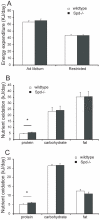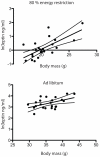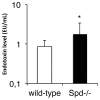Surfactant protein d deficiency in mice is associated with hyperphagia, altered fat deposition, insulin resistance, and increased basal endotoxemia
- PMID: 22509382
- PMCID: PMC3324408
- DOI: 10.1371/journal.pone.0035066
Surfactant protein d deficiency in mice is associated with hyperphagia, altered fat deposition, insulin resistance, and increased basal endotoxemia
Abstract
Pulmonary surfactant protein D (SP-D) is a host defence lectin of the innate immune system that enhances clearance of pathogens and modulates inflammatory responses. Recently it has been found that systemic SP-D is associated with metabolic disturbances and that SP-D deficient mice are mildly obese. However, the mechanism behind SP-D's role in energy metabolism is not known.Here we report that SP-D deficient mice had significantly higher ad libitum energy intake compared to wild-type mice and unchanged energy expenditure. This resulted in accumulation but also redistribution of fat tissue. Blood pressure was unchanged. The change in energy intake was unrelated to the basal levels of hypothalamic Pro-opiomelanocortin (POMC) and Agouti-related peptide (AgRP) gene expression. Neither short time systemic, nor intracereberoventricular SP-D treatment altered the hypothalamic signalling or body weight accumulation.In ad libitum fed animals, serum leptin, insulin, and glucose were significantly increased in mice deficient in SP-D, and indicative of insulin resistance. However, restricted diets eliminated all metabolic differences except the distribution of body fat. SP-D deficiency was further associated with elevated levels of systemic bacterial lipopolysaccharide.In conclusion, our findings suggest that lack of SP-D mediates modulation of food intake not directly involving hypothalamic regulatory pathways. The resulting accumulation of adipose tissue was associated with insulin resistance. The data suggest SP-D as a regulator of energy intake and body composition and an inhibitor of metabolic endotoxemia. SP-D may play a causal role at the crossroads of inflammation, obesity, and insulin resistance.
Conflict of interest statement
Figures






References
-
- Sorensen GL, Husby S, Holmskov U. Surfactant protein A and surfactant protein D variation in pulmonary disease. Immunobiology. 2007;212:381–416. - PubMed
-
- Fujita M, Shannon JM, Ouchi H, Voelker DR, Nakanishi Y, et al. Serum surfactant protein D is increased in acute and chronic inflammation in mice. Cytokine. 2005;31:25–33. - PubMed
-
- Leth-Larsen R, Nordenbaek C, Tornoe I, Moeller V, Schlosser A, et al. Surfactant protein D (SP-D) serum levels in patients with community-acquired pneumonia. Clin Immunol. 2003;108:29–37. - PubMed
-
- Greene KE, Wright JR, Steinberg KP, Ruzinski JT, Caldwell E, et al. Serial changes in surfactant-associated proteins in lung and serum before and after onset of ARDS. Am J Respir Crit Care Med. 1999;160:1843–1850. - PubMed
-
- Akiyama J, Hoffman A, Brown C, Allen L, Edmondson J, et al. Tissue distribution of surfactant proteins A and D in the mouse. J Histochem Cytochem. 2002;50:993–996. - PubMed
Publication types
MeSH terms
Substances
LinkOut - more resources
Full Text Sources
Molecular Biology Databases
Miscellaneous

